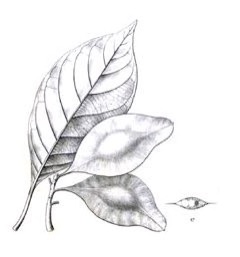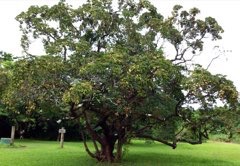 |
|
http://www.edibleplants.org |
 |
| Wendy Cutler flickr.com |
Translate this page:
Summary
Terminalia sambesiaca is an evergreen tree tree with a dense crown and grows up to 40 m high and 90 cm in trunk diameter. The trunk is usually straight, cylindrical, and slightly buttressed. It is a fast-growing tree commonly found in East tropical Africa. Traditionally, it is used against stomach pain, infertility in women, fever, colds, cancer, stomach ulcers, appendicitis, and diarrhea. Further, it exhibits antibacterial and antifungal properties. No plant part is edible. The wood is moderately heavy, moderately durable, and susceptible to termite attack. It is used for poles, stools, mortars, tool handles, construction, flooring, shipbuilding, furniture, toys, veneer, plywood, etc. It is also used for fuel and charcoal.
Physical Characteristics

 Terminalia sambesiaca is an evergreen Tree growing to 32 m (105ft) by 32 m (105ft) at a fast rate.
Terminalia sambesiaca is an evergreen Tree growing to 32 m (105ft) by 32 m (105ft) at a fast rate.
See above for USDA hardiness. It is hardy to UK zone 10.
Suitable for: light (sandy), medium (loamy) and heavy (clay) soils and prefers well-drained soil. Suitable pH: mildly acid, neutral and basic (mildly alkaline) soils. It cannot grow in the shade. It prefers dry or moist soil.
UK Hardiness Map
US Hardiness Map
Synonyms
Terminalia aemula Diels Terminalia foetens Engl. Terminalia obovata Sim Terminalia riparia Engl. & D
Plant Habitats
Edible Uses
References More on Edible Uses
Medicinal Uses
Plants For A Future can not take any responsibility for any adverse effects from the use of plants. Always seek advice from a professional before using a plant medicinally.
Antibacterial Antidiarrhoeal Antifungal Cancer Febrifuge
In traditional medicine the leaves are used to treat stomach-ache and infertility in women, whereas bark and leaf decoctions are applied to treat fever, colds, cancer, stomach ulcers and appendicitis. Powdered root bark is mixed with porridge and eaten to treat bloody diarrhoea[299 , 364 ]. Methanol extracts of the roots showed marked antibacterial activity against Enterobacter aerogenes, Micrococcus luteus, Pseudomonas aeruginosa, Sarcina sp., Salmonella typhi, Shigella boydii, Staphylococcus aureus and Staphylococcus epidermidis, as well as distinct antifungal activity against Candida albicans, Candida glabrata and Cryptococcus neoformans. Bark extracts also showed antibacterial activity and leaf extracts antifungal properties against Candida albicans and Cryptococcus neoformans. Antifungal activity was found especially in polar fractions of the extract and might be due to the presence of tannins. Root extracts showed strong cytotoxic effects against several human cancer cell lines, e.g. Against HeLa cervical cancer cells, T24 bladder cancer cells and BBCE endothelial cells[299 ].
References More on Medicinal Uses
The Bookshop: Edible Plant Books
Our Latest books on Perennial Plants For Food Forests and Permaculture Gardens in paperback or digital formats.

Edible Tropical Plants
Food Forest Plants for Hotter Conditions: 250+ Plants For Tropical Food Forests & Permaculture Gardens.
More

Edible Temperate Plants
Plants for Your Food Forest: 500 Plants for Temperate Food Forests & Permaculture Gardens.
More

More Books
PFAF have eight books available in paperback and digital formats. Browse the shop for more information.
Shop Now
Other Uses
Charcoal Fuel Furniture Tannin Wood
Other Uses: The heartwood is yellow with brownish stripes on quarter-sawn surfaces, darkening rapidly to yellowish brown or greenish brown; it is distinctly demarcated from the up to 6cm wide band of cream-coloured sapwood. The grain is interlocked; the texture fine and even. The wood is moderately heavy, moderately durable, being susceptible to termite attack. It seasons fairly rapidly, with little degrade, though surface checking and some distortion may occur, especially in kiln drying; once dry, the wood is moderately stable in service. It is moderately difficult to saw and work with hand and machine tools; it often finishes well, but the use of a filler has been recommended to produce good surfaces; nailing and screwing are good, but require pre-boring. The wood is used for building poles, ship masts, stools, mortars, tool handles and beehives. It is suitable for construction, flooring, joinery, interior trim, bridge decking, ship building, furniture, cabinet work, sporting goods, toys, novelties, railway sleepers, mine props, veneer and plywood[299 , 364 ]. The wood is used for fuel and for charcoal production[299 , 364 ].
Special Uses
References More on Other Uses
Cultivation details
The tree is said to grow rapidly[299 ]. The flowers have a strong and unpleasant smell, and are probably pollinated by flies[299 ]. Although this species has been reported to be an excellent timber tree, very little is known about its growth rates, propagation and possibilities for establishing plantations[299 ].
References Carbon Farming Information and Carbon Sequestration Information
Temperature Converter
Type a value in the Celsius field to convert the value to Fahrenheit:
Fahrenheit:
The PFAF Bookshop
Plants For A Future have a number of books available in paperback and digital form. Book titles include Edible Plants, Edible Perennials, Edible Trees,Edible Shrubs, Woodland Gardening, and Temperate Food Forest Plants. Our new book is Food Forest Plants For Hotter Conditions (Tropical and Sub-Tropical).
Shop Now
Plant Propagation
Seed -
Other Names
If available other names are mentioned here
Native Range
Coming Soon
Weed Potential
Right plant wrong place. We are currently updating this section.
Please note that a plant may be invasive in one area but may not in your area so it's worth checking.
Conservation Status
IUCN Red List of Threatened Plants Status : This taxon has not yet been assessed

Growth: S = slow M = medium F = fast. Soil: L = light (sandy) M = medium H = heavy (clay). pH: A = acid N = neutral B = basic (alkaline). Shade: F = full shade S = semi-shade N = no shade. Moisture: D = dry M = Moist We = wet Wa = water.
Now available:
Food Forest Plants for Mediterranean Conditions
350+ Perennial Plants For Mediterranean and Drier Food Forests and Permaculture Gardens.
[Paperback and eBook]
This is the third in Plants For A Future's series of plant guides for food forests tailored to
specific climate zones. Following volumes on temperate and tropical ecosystems, this book focuses
on species suited to Mediterranean conditions—regions with hot, dry summers and cool, wet winters,
often facing the added challenge of climate change.
Read More
Expert comment
Author
Engl. & Diels
Botanical References
Links / References
For a list of references used on this page please go here
A special thanks to Ken Fern for some of the information used on this page.
Readers comment
| Add a comment |
|
If you have important information about this plant that may help other users please add a comment or link below. Only comments or links that are felt to be directly relevant to a plant will be included. If you think a comment/link or information contained on this page is inaccurate or misleading we would welcome your feedback at [email protected]. If you have questions about a plant please use the Forum on this website as we do not have the resources to answer questions ourselves.
* Please note: the comments by website users are not necessarily those held by PFAF and may give misleading or inaccurate information.
To leave a comment please Register or login here All comments need to be approved so will not appear immediately.
|
Subject : Terminalia sambesiaca
|
|
|
|